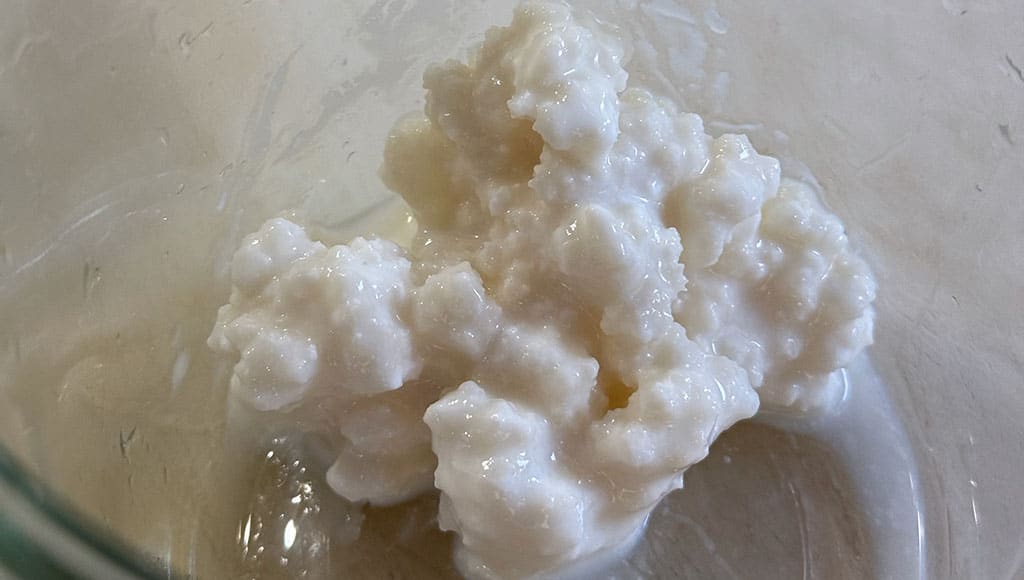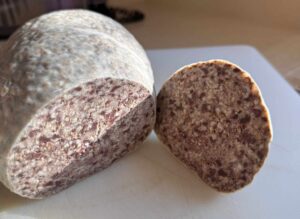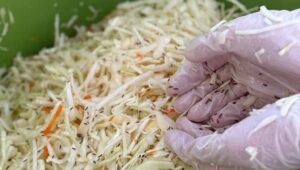I have got a new friend; it is called SCOBY*. In Mexico, however, it is Bulgaros; in Northern Caucasus, Kumis; in Sweden, they call it Filmjölk; and in Finland, it goes by Viili and Piimä. This host of names refers to the products commonly known as kefir.
On the surface, kefir is a mere fermented milk drink. But underneath, there is a vibrant and complex microbial profile. Every sip of this refreshing drink can contain up to 50 different types of bacteria, which transform themselves into strands such as Lactobacillus kefiranofaciens, Lactobacillus acidophilus, and Lactobacillus brevis. If that was not enough, kefir also contains beneficial yeasts like Saccharomyces and Kluyveromyces. All of this diversity is what grants kefir its countless health properties, from gut health and cardiovascular benefits to bone strength and healthy skin.
What turns a glass of milk into a microbial parade is SCOBY, a *symbiotic culture of bacteria and yeast. It comes in the form of grains, aka a kefir starter or kefir grains. Slightly squishy and rubbery to touch, kefir SCOBY resembles a string of pearls connected in a random fashion looking more like a handful of cauliflower rather than a necklace. No other dairy product, but kefir, requires a starter like SCOBY.
Scientifically, the grains are believed to have been formed from adding and removing milk from animal skin bottles. The symbiosis of microorganisms present during this process forged colonies of yeast and bacteria in the form of grains.
In folklore, grains are lovingly called the ‘seeds of the prophet’. The legend has it that Prophet Muhammad gifted them to the nomadic people of Northern Caucasus to help preserve milk. Ever since, Caucasians have been a model of good health, which at the start of 20th century became a subject of interest for many, including the Blandov brothers, the Russian cheesemakers. Since sharing was strictly prohibited, the brothers conspired with a butter-maker, Irina Sakharova, who through seduction, charm and espionage managed to obtain the grains from one of the Caucasian princes. From there, kefir marched through the world and was taken up by many cultures, hence those many names mentioned at the start of the post.
Fundamentally there are two choices concerning the supply of kefir: one can buy or make it. And I can tell you with confidence, nothing tastes better than home-made kefir. Thankfully, the process is easy.
To come into possession of some kefir grains one can either go online or ask around. You would be surprised how many people already have them. For me, it was my hairdresser.
Once you hold the grains, simply submerge them in your milk of choice and wait. For me, a tablespoon of grains ferments half a litre of milk in 18-24 hours in the kitchen at 20-21ºC. After a few ferments, your specific ratio will reveal itself. The final product should be a soft and jiggly mass. To build a healthy relationship with the grains, consider the following:
- Kefir can take a break in the refrigerator. It slows down the fermentation to 10-14 days.
- No need to wash grains between ferments. A noticeable gooey film between the grains is a habitat for the microbial goodness. Simply strain them, and place into a new batch of milk.
- The product of the first fermentation can be fermented further to develop flavour. Called the second fermentation, it is applied to the product only, no grains, that when collected is sent to the fridge for another 4-8hrs.
- Kefir grains work aerobically and anaerobically, ie with or without oxygen or with an open or tight lid. Kefir with restricted airflow will be more acidic.
- Kefir can be stirred. In fact, the grains like that. Historically, sacks with kefir were hung above the entrance door, so that guests would give it a smack when entering.
- Kefir loves lactose. It consumes it during the process of fermentation, therefore the final product becomes nearly lactose free.
Aside from drinking, kefir is a fab culinary ingredient. Try it in one of the following scenarios.
- Smoothies: Blend kefir with fruits, vegetables, and other ingredients for a nutritious smoothie.
- Salad dressings: Use kefir as a base for creamy dressings by mixing it with herbs, spices, and a bit of vinegar or lemon juice.
- Baking: Substitute kefir for buttermilk or yogurt in recipes for pancakes, muffins, bread, or cakes to add moisture and a tangy flavour.
- Soups: Stir kefir into soups, particularly chilled soups like gazpacho; Russian soups like holodnik or okroshka also call for kefir.
- Marinades: Use kefir as a tenderising marinade for meats, combining it with spices and herbs for flavour.
- Porridge: Pour kefir over oatmeal, cereal or other grains for a nutritious breakfast, or mix it into overnight oats.
- Sauces: Incorporate kefir into sauces for dishes like curry to add creaminess.
- Treats: Use kefir to make ice pops or panna cotta for a healthy and delicious dessert.
- Cheese. Use kefir to make homemade soft cheese.
By Dr. Irina Mikhailava
|| features@algarveresident.com
Dr. Irina Mikhailava, a chef and a good food champion, happily residing in the Algarve and eating all over the world with an appetite for learning, sharing and writing. Instagram: incompanyoffood


























